List of World Heritage Sites in Bulgaria facts for kids
Imagine places so special they are protected for everyone in the world! These are called World Heritage Sites. They are chosen by the United Nations Educational, Scientific and Cultural Organization. UNESCO is a group that helps protect important cultural and natural places around the globe.
A place can be chosen if it has amazing cultural value, like old buildings or art. It can also be chosen if it has incredible natural beauty or important wildlife. Bulgaria agreed to protect these sites in 1974.
As of 2022, Bulgaria has ten World Heritage Sites. The first four were added in 1979. These include the Boyana Church and the Madara Rider. Seven of Bulgaria's sites are cultural, and three are natural. One site, the Ancient and Primeval Beech Forests of the Carpathians and Other Regions of Europe, is shared with 17 other countries. Bulgaria also has 16 more sites that might become World Heritage Sites in the future.
Bulgaria's World Heritage Sites
UNESCO uses ten special rules, called criteria, to pick World Heritage Sites. Each site must meet at least one of these rules. Rules one to six are for cultural sites. Rules seven to ten are for natural sites.
* Transnational site
| Site | Image | Location | Year listed | UNESCO data | Description |
|---|---|---|---|---|---|
| Boyana Church |  |
Sofia | 1979 | 42; ii, iii (cultural) | The Boyana Church is a beautiful Bulgarian Orthodox church. It is located just outside the city of Sofia. This church is actually three buildings put together. The oldest part was built in the 10th century. The newest part was added in the early 19th century.
The church has amazing wall paintings, called frescos. Some of these frescos are from the 13th century. They are considered some of the best art from that time. These paintings have been carefully fixed up in recent years. |
| Madara Rider |  |
Shumen Province | 1979 | 43; i, iii (cultural) | The Madara Rider is a huge carving on a rock. It shows a knight on a horse. The knight is winning a fight against a lion. You can also see a bird and a dog in the carving.
This carving is on a cliff that is 100 meters (about 328 feet) tall. It is 23 meters (about 75 feet) up the cliff. It was made around the early 8th century. This was when Madara was a holy place for the First Bulgarian Empire. There are also old Greek writings near the carving. They tell stories about the early Bulgarian state and its leaders, called khans. |
| Kazanlak Thracian Tomb | 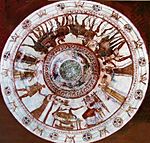 |
Stara Zagora Province | 1979 | 44; i, iii, iv (cultural) | This tomb is from the end of the 4th century BCE. That's over 2,300 years ago! It is a special type of tomb called a beehive tomb. It has a narrow path and a round room for burials.
The paintings inside the tomb are very old. They show the culture and burial traditions of the Thracian people. The tomb is part of a bigger burial ground. This area is near the ancient Thracian city of Seuthopolis. The tomb was found in 1944. Its paintings are still in great condition. |
| Ivanovo Rock-Hewn Churches |  |
Ruse Province | 1979 | 45; ii, iii (cultural) | In the 12th century, religious people called hermits started carving churches and rooms into cliffs. These cliffs are above the Rusenski Lom river. The churches are near the village of Ivanovo.
The frescos inside these churches are from the 14th century. They were made during the Second Bulgarian Empire. These paintings are some of the best examples of the Palaeologues style. They show new ways of painting compared to older Byzantine art. |
| Rila Monastery | 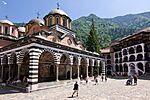 |
Kyustendil Province | 1983 | 216; vi (cultural) | The Rila Monastery was started in the 10th century. It was founded by Saint John of Rila. For hundreds of years, it was a very important place for Bulgarian culture and religion. It was especially important during the time of Ottoman rule in Bulgaria.
A fire destroyed the monastery in the early 1800s. But it was rebuilt between 1834 and 1862. This was during a time when Bulgarians were rediscovering their national identity. |
| Ancient City of Nessebar | 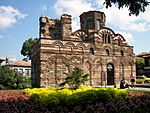 |
Burgas Province | 1983 | 217; iii, iv (cultural) | The city of Nessebar is on the coast. It began as a Thracian settlement. Then, in the 6th century BCE, it became a Greek colony on the Black Sea. Many old buildings are from the Hellenistic period. These include an acropolis and a temple for the god Apollo.
Nessebar was an important Christian city during the Middle Ages. You can still see a basilica and a fortress from that time. In the 19th century, wooden houses were built in the style of the Bulgarian National Revival. |
| Srebarna Nature Reserve | 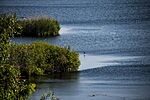 |
Silistra Province | 1983 | 219bis; x (natural) | Lake Srebarna and the wet areas around it are near the Danube river. This place is very important for birds. Many birds come here to breed, spend the winter, or stop during their long journeys.
About 178 types of birds have been seen here. Some of them are rare or in danger of disappearing. The lake is home to the biggest group of Dalmatian pelicans in Bulgaria. In 2008, a small change was made to the reserve's borders. |
| Pirin National Park |  |
Blagoevgrad Province | 1983 | 225bis; vii, viii, ix (natural) | This national park is in the Pirin Mountains. It has many different kinds of mountain areas. You can find pine forests, high mountain meadows, and tall peaks. The highest peak is 2,914 meters (about 9,560 feet) tall.
The park is home to many plants and animals. This includes animals like brown bears and wolfes. The park's boundaries were made larger in 2010. |
| Sveshtari Thracian Tomb | 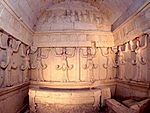 |
Razgrad Province | 1985 | 359; i, iii (cultural) | This Thracian tomb was built in the 3rd century BCE. It was found in 1982. The decorations inside are very well preserved. It is a rare example of Thracian building style.
The tomb shows the art of the local Gets people. Their art was inspired by Hellenism, which was Greek culture. A special part of the tomb is 10 caryatids. These are statues that are half women and half plants. |
| Ancient and Primeval Beech Forests of the Carpathians and Other Regions of Europe* | 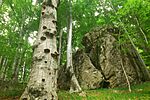 |
several sites | 2017 | 1133ter; ix (natural) | These very old beech forests are important for studying how the European beech tree (Fagus sylvatica) spread. They show how these trees grow in many different environments. This site is shared with 17 other countries in Europe.
The site was first listed in 2007 in Romania and Ukraine. More parts were added in 2011. Then in 2017, nine areas within Bulgaria's Central Balkan National Park were added. The site was expanded again in 2021. |
Sites Bulgaria May Nominate
Besides the sites already on the World Heritage list, countries can also keep a list of "tentative" sites. These are places they might want to nominate in the future. A site must be on this tentative list before it can be considered for the main World Heritage list. As of 2022, Bulgaria has 16 sites on its tentative list.
| Site | Image | Location | Year listed | UNESCO criteria | Description |
|---|---|---|---|---|---|
| Two Neolithic Dwellings | Stara Zagora Province | 1984 | iii, iv (cultural) | This nomination is for two very old homes from the Neolithic period. They are about 8,000 years old! These homes are in the city of Stara Zagora. They are incredibly well preserved. They are considered the best examples in the world from that time.
Many old household items were found here. These include pottery, jewelry, stone tools, and grinding stones. Old ovens were also found. A special museum has been built over the site. This allows visitors to see these ancient homes. |
|
| Magoura Cave with Bronze Age Drawings |  |
Vidin Province | 1984 | (cultural) | The Magoura Cave is near the village of Rabisha. It has many rooms and tunnels you can explore. People lived in this cave during the Bronze Age and early Iron Age.
Signs of ancient settlements have been found in the cave. There are also drawings on the walls. These drawings were likely part of old rituals. |
| The Ancient Town of Nicopolis ad Istrum | 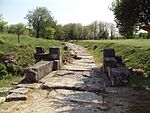 |
Veliko Tarnovo Province | 1984 | iii, iv (cultural) | This town was built by the Roman Emperor Trajan. It was started in the early 2nd century CE. This was after the Dacian Wars. The town had a planned layout with straight streets. It was surrounded by strong walls.
The town even made its own coins. During the Byzantine period, it was an important church center. But it was destroyed by the Avars in the late 6th century. |
| Late Ancient Tomb of Silistra | 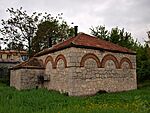 |
Silistra Province | 1984 | i, iii (cultural) | This Roman tomb is from the 4th century CE. It is in the town of Silistra. It is a rare example of old Roman painting that is still well preserved. The walls are completely covered with murals.
A band of paintings goes around the walls. It shows 11 scenes of male and female servants. They are bringing gifts and clothes to their masters. |
| The Bachkovo Monastery |  |
Plovdiv Province | 1984 | i, iv, vi (cultural) | The Bachkovo Monastery was founded in the 11th century. It is one of the oldest monasteries in the Balkans. This monastery shows a special mix of three cultures from the Middle Ages. These are Bulgarian, Byzantine, and Georgian cultures.
The bone house, called an ossuary, is from the original monastery. The Church of the Holy Archangels was built between the 12th and 14th centuries. The dining hall was built in the 17th century. Many wall paintings from different times have been saved here. |
| The Town of Melnik and the Rozhen Monastery |  |
Blagoevgrad Province | 1984 | i, iv (cultural) | This nomination includes the old town of Melnik. It also includes the fortress above it and the nearby monastery. They are in a beautiful area surrounded by natural sand pyramids.
The monastery was started in the Middle Ages. Parts of it were built from the 16th to the 19th centuries. It has old wall paintings and wooden altars. |
| The Roussensky Lom National Park | 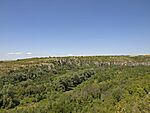 |
Ruse Province | 1984 | (natural) | The canyon of the Rusenski Lom river is home to many bird species. You can find birds like the saker falcon, Egyptian vulture, golden eagle, and long-legged buzzard here. |
| The Ancient Plovdiv | 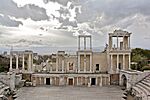 |
Plovdiv Province | 2004 | ii, iv, vi (cultural) | The city of Plovdiv is on an important route through the Balkans. People have lived here since prehistoric times. The city has many old buildings. There is a Roman theatre and a stadium from ancient Roman times.
You can also see remains from the medieval period. There are houses built in the Ottoman style. And there are buildings from the Bulgarian National Revival period. |
| Thracian Tomb with Wall Paintings near Alexandrovo Village |  |
Haskovo Province | 2004 | i, ii, iii (cultural) | This Thracian tomb is near the village of Aleksandrovo. It was built in the second half of the 4th century BCE. Both the front room and the main burial room have well-preserved frescos. The paintings show scenes of boar and deer hunting. |
| Vratsa Karst Nature Reserve |  |
Vratsa Province | 2011 | vii, viii, ix, x (natural) | This nature reserve is in the western part of the Balkan Mountains. It has many karst formations. These include sinkholes, deep gorges, and caves. The cliffs of the Vratsata Gorge are 450 meters (about 1,476 feet) high.
The area is also important for its many different plants and animals. Mediterranean plants grow here on limestone, even though it's far from the Mediterranean Sea. |
| Belogradchik Rocks | 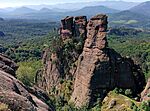 |
Vidin Province | 2011 | vii, viii (natural) | This nomination includes rock formations made of sand and limestone. They are near the town of Belogradchik. Some of these rock formations are over 20 meters (about 65 feet) tall.
They come in many different shapes. People often imagine them as human figures or animals. |
| Central Balkan National Park |  |
Lovech, Gabrovo, Sofia, Plovdiv, and Stara Zagora provinces | 2011 | vii, viii, ix, x (natural) | This national park stretches for 85 kilometers (about 53 miles) in the Balkan Mountains. It has many different types of natural areas. These include forests, meadows, mountain pastures, and rocky peaks. Some peaks are up to 2,376 meters (about 7,795 feet) high.
The park has several very old European beech (Fagus sylvatica) forests. It is also home to many plant species that are found nowhere else. |
| Pobiti Kamani Natural Monument |  |
Varna Province | 2011 | vii, viii (natural) | This nomination includes several groups of limestone rock formations. They were formed by erosion from old sediments. They are located along the Black Sea coast. The landscape here looks a bit like a desert.
One idea is that some of these structures formed around natural methane gas vents. |
| Royal Necropolis of the Thracian City of Seuthopolis | 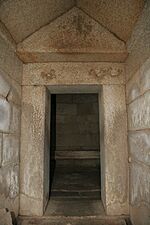 |
Stara Zagora Province | 2016 | i, ii, iii, iv (cultural) | This nomination wants to add more tombs to the existing World Heritage Site, the Thracian Tomb of Kazanlak. Eight tombs are included in this new proposal. They are part of a burial ground near the ancient Thracian city of Seuthopolis. This city was the capital of King Seuthes III.
These tombs are from the 4th and 3rd centuries BCE. They show a mix of Thracian and Hellenistic (Greek) influences. The Thracian tomb Golyama Arsenalka is shown in the picture. |
| Bishop's Basilica and Late-Antique Mosaics of Philippopolis | 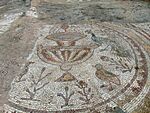 |
Plovdiv Province | 2018 | ii, iii, iv, vi (cultural) | This nomination includes a large church, called a basilica, and two other buildings. They are from the 2nd to the 6th century. They were in the city of Philippopolis, which is now Plovdiv. This was an important city in the Roman Empire.
The floor mosaics in the basilica are amazing. They have been found since the 1980s. They are some of the largest collections of early Christian mosaics still in their original place. |
| Frontiers of the Roman Empire – The Danube Limes (Bulgaria)* | 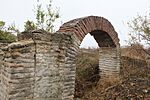 |
several sites | 2020 | ii, iii, iv (cultural) | This is a shared nomination with other countries. It covers sites with Roman forts and walls along the Danube river. These were part of the Roman Empire's borders. The ruins at Ratiaria are shown in the picture. |
See also
 In Spanish: Anexo:Patrimonio de la Humanidad en Bulgaria para niños
In Spanish: Anexo:Patrimonio de la Humanidad en Bulgaria para niños

